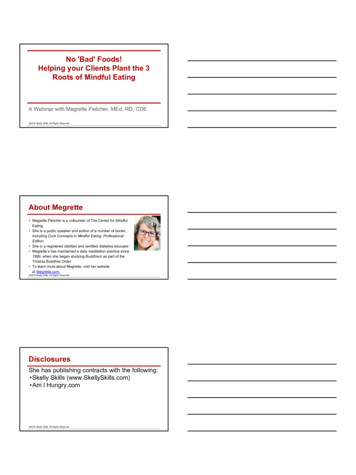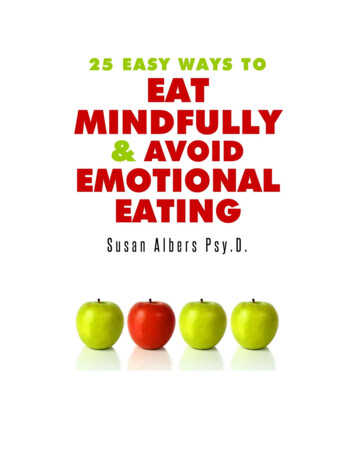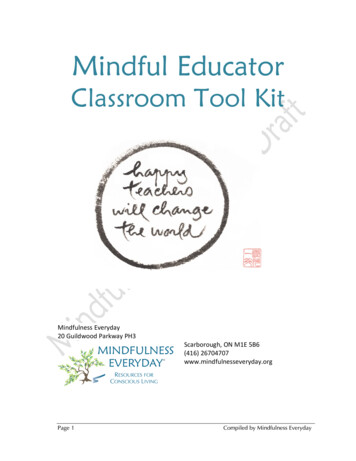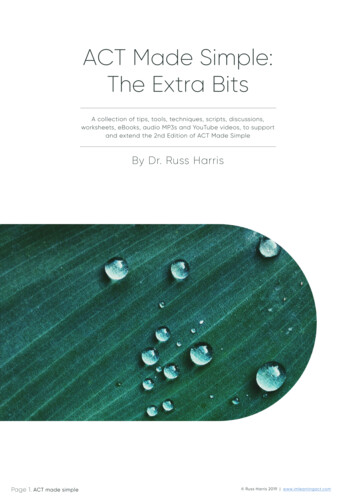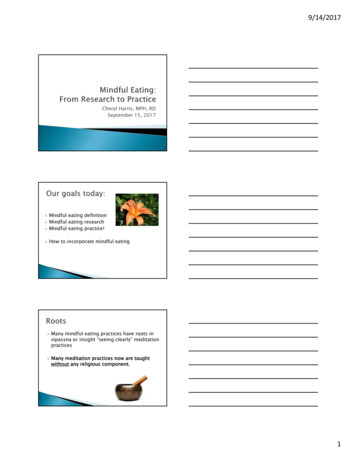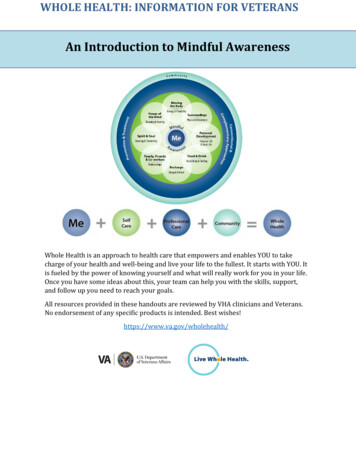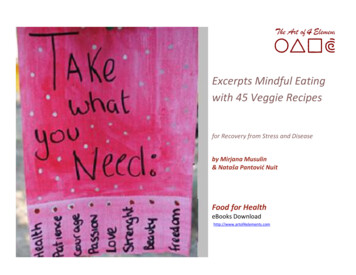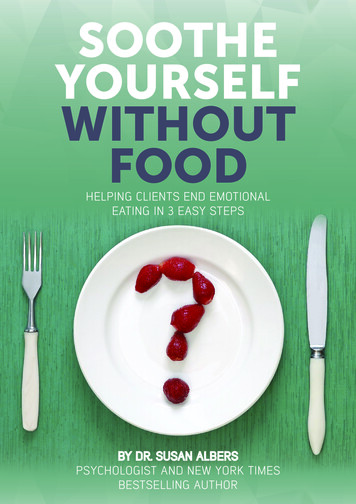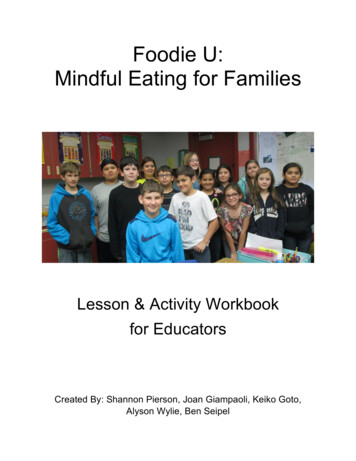
Transcription
Foodie U:Mindful Eating for FamiliesLesson & Activity Workbookfor EducatorsCreated By: Shannon Pierson, Joan Giampaoli, Keiko Goto,Alyson Wylie, Ben Seipel
Table of ContentsI.Acknowledgments . . 4II.Introduction to Mindful Eating . 5III.Mindful Eating Practice . 6IV.Lesson 1 - Master Mindless Munching — Your environment may be tricking youinto eating mindlessly. Discover how awareness helps us avoid these sneaky foodtraps.Master Mindless Eating: Lesson Plan . . . 7 - 13Master Mindless Eating: Take-Home Activity . . .14V.Lesson 2 - Sensational Senses — Have fun using all of your senses to exploreyour surroundings and food in a brand new way. Food never tasted so good!Sensational Senses: Lesson Plan . . 15 - 19Sensational Senses: Take-Home Activity . . . . 20VI.Lesson 3 - Getting to Know Hunger & Fullness — Practice noticing feelings andthe meaning of hunger and fullness signals. When you learn to listen, your body tellsyou when to start and stop eating!Getting to Know Hunger & Fullness: Lesson Plan . 21 - 25Handout: Hunger & Fullness Examples and Scale . 26 - 27Getting to Know Hunger & Fullness: Take-Home Activity . . . 28VII.Lesson 4 - Emotions Inside & Out — Practice noticing the difference betweenphysical hunger and when you may be eating for other reasons. Emotions canchange how you make choices about food. Learning to notice your thoughts andfeelings can help you make healthier choices more often!Emotions Inside & Out: Lesson Plan . . .29 - 33Handout: Healthy Body, Mind & Heart: Making Choices 34Emotions Inside & Out: Take-Home Activity. . . 35VIII.Lesson 5 - Planting Seeds of Mindfulness — Experience a sense of connectionand appreciation as you follow the incredible journey of a seed from the garden toyour plate. Then plant your own seed and watch it grow!Planting Seeds of Mindfulness Lesson Plan . . 36 - 39Planting Seeds of Mindfulness Take-Home Activity. . 40 - 41IX.Lesson 6 - Family Culture Celebration Feast — Practice using all of your mindfuleating skills in one fun meal that celebrates the importance of food, family, friends,and traditions in your life!Family Culture Celebration Lesson Plan . . 42 - 45Handout: Get Cooking - Little Hands Can Be A BIG Help . 462
Writing Activity: Write or draw a story about your family traditions .47Cultural Feast Take-Home Activity . . . 48X.Mindful Eating Challenges . .49 - 51XI.Handouts & Take-Home Activities in Spanish . .52 - 633
AcknowledgementsCurriculum and Activities created by the Foodie U Mindful Eating Research Team:Shannon Pierson, MSJoan Giampaoli, PhD, RDKeiko Goto, PhDAlyson Wylie, MATBen Seipel, PhDCalifornia State University, ChicoCenter for Healthy CommunitiesSpecial thanks to the following for making the Foodie U Mindful Eating Research projectpossible:Kevin Buffardi, PhDCarina ChiodoKristin GruneisenCatherine HannayJennifer JoyceGauri KarnikChristina MartinezAlexxa McCombRocio Mendez-Estrada, MSMark MonizAmie PorrasCourtney RhodesSandy ThaoChristopher WillardKatie WilliamsCindy Wolff, PhD, RD, MPASheng YangFoodie U: Mindful Eating for Mindful Families is a seed grant project # 2015-6900123238 of the Agricultural and Food Research Initiative program funded through theUnited States Department of Agriculture.4
Introduction to Mindful EatingWhat is Mindful Eating? Paying attention to the present moment when choosing, preparing, and eatingyour food. Awareness that food is more than just something to fill you up. Using all of your senses to explore, savor, and enjoy food. Noticing thoughts and feeling about food and yourself without judgment. Listening to body signals of hunger and fullness to decide when you should startand stop eating.Why Practice Mindful Eating? Focus on enjoying food and the eating experience. Maintain and enjoy cultural and family traditions. Learn to recognize a comfortable level of fullness. Respond to food cravings in healthful ways. Improve self-acceptance and self-management.Why Use This Manual Fun activities and discussion topics for students and the whole family to enjoytogether. Learn ways to make small changes to your environment that can make healthyeating habits easier. Improve awareness about how and why you and your family members makechoices about food. Everyone can learn to be more mindful eaters with a healthy, happy relationshipwith food - it just takes practice!5
Mindful Eating Practice“An experience that engages all parts of us, our body, our heart, and our mind,in choosing, preparing, and eating food.” - Jan Chozen BaysInstructions: Pick any food to explore! Follow the guide below.Practice often and have fun enjoying food with greater awareness!“Look at the (food’s name). What is its shape? What size is it? What color is the(food)? What smell do you notice? What sensation do you notice in your mouth as youlook at the (food)? What’s the feeling in your stomach? Pick up the food slowly. Hold the(food) in your fingers and look at it in your grasp. What does the (food) feel like in yourhand: its texture, temperature?Bring the (food) slowly to your lips. Before putting the food to your mouth, pause and beaware of what you are experiencing in your mouth. Slowly open and place the (food) onyour tongue for a moment without biting into it. Feel what your mouth wants to do withthis (food). Take a few moments before you bite into it. Feel its texture on your tongueand in your mouth. What do you taste?Now bite into it noticing what you taste and what it feels like. As you continue to taste,try not to swallow the (food) right away. Does the taste and feeling change as you arechewing? Feel the food going down as you swallow. Refocus on your mouth. Noticeyour stomach and what it may be feeling. Notice what you are feeling? Now you havefinished your exercise.”Printed and adapted with permissionAdapted from: Willard, Christopher, 2010, A Child’s Mind: Mindful Practice to Help Our ChildrenBe More Focused, Calm, and Relaxed, Parallax Press, CA6
Lesson 1: Master Mindless MunchingIntention of Educator: To help students recognize that cues from their environment can impactwhat and how much they choose to eat, and to help students make the connection that beingaware of these tricky environmental cues can empower them to make more healthful foodchoices while still being satisfied.Goal: Students will learn at least three ways to minimize the effects of environmental cues ontheir consumption of food and beverages at home.Objectives: Students will recognize that eating while distracted can lead to eating more thanintended.Demonstrate that size of plates and shape of glassware can influence portion size andconsumption.Demonstrate that convenient food is more likely to be overeaten and apply the conceptto making healthier choices at home.Nutrition Lesson Time: 45-50 minutesMaterials Needed: 1 tall, skinny glass 2 small plates 1 short, wide glass Mashed potatoes Large bottle of water Serving spoon 2 large plates 1 c liquid measuring cup (x2) 4 c liquid measuring cup Popcorn tastings Take home activity kits Home Practice Activity Sheets Unpopped popcorn Parent Feedback Survey Mindful Eating Challengechoices Mindful Eating Challengetracking calendar7
In-Class Lesson Outline Introduction (5 minutes) Foodie U Expectations and Ground Rules Physical Activity (5 minutes) Mindless Mimes & Group Discussion (10 minutes) Food Traps (20 minutes) Station 1: Glassware Gimmicks Station 2: Portion Distortion Physical Activity (optional, 1-5 minutes) Tasting (5 minutes) Wrap Up (5 minutes) Check for understanding Take home activityBefore the Lesson: Prepare mashed potatoes. Verify that your short, wide glass holds the same or more liquid than your tall, glass. Write on the board:I agree to treat my peers, my teachers, and myself with respect today.Today my intention is to notice things around me that trick my body into eating morethan it really needs. During the introduction and physical activity, staff should portion sunflower seeds outinto paper cups. Half of the cups should have shelled sunflower seeds, and the otherhalf should have unshelled sunflower seeds.8
Master Mindless MunchingIntroduction:Foodie U (2 minutes)Say:Hello, my name is and these are my friends and . We arecollege students studying nutrition at Chico State University. We heard that students atMetteer love to learn and try new things. Is that true? Then you all definitely have what ittakes to go study at college too one day if you want to. That is very exciting, so we arereally happy to tell you that you have all been accepted into a new program calledFoodie University! We will have 6 Foodie U lessons total this school year so we can allbecome food scientists by learning to explore the food we eat in new, more mindfulways. Being “mindful” just means being more aware of what’s going on right now, in thepresent moment. Each month we will practice new skills in class to learn more about ourfood, our bodies, and our minds. We will do lots of fun activities and experiments, tastefoods in new ways, and get to know our bodies better. After each class you will have thechance to share and practice what you learned with your family at home, too.Expectations: Ground Rules and Respect (1 minute)Say:Since we are all going to be Foodie U students, it is very important that we all agree totreat each other with respect at all times. Who knows what respect means? Yes! Thatmeans participating in class activities with a positive attitude, raising our hands when wewould like to speak, listening to one another without interrupting, and being respectful ofothers’ ideas even if they are different from yours. Who likes that idea? Now that we allunderstand, let’s make a class pact by raising our right hands and reading thisagreement outloud: I agree to treat my peers, my teachers, and myself with respecttoday. Thank you! This means that we will get to use all of our time enjoying each other’scompany and doing interesting thingsToday we are going to explore reasons why we sometimes mindlessly munch on morethan we mean to. Let’s all set a goal for what we want to focus on today.Read together off the board: Today my focus is to notice things around me that trick mybody into eating more than it really needs.9
In-Class Activity: Mindless Mimes (10 minutes)Say:For our first activity, we are going to need Foodie Fans who want to practice their actingskills. If you volunteer, you will draw a piece of paper from this bowl and then act outwhat is written. This is like charades, so the only trick is you CANNOT talk! You CANuse props including other people.Everyone else will try to guess what you are acting out. Once the group guessescorrectly, say what was written on the card, take a bow, and then have a seat again.Charade Prompts - Situations that can lead to mindless eating: Say:You feel bored so you look for something to eatYou are really REALLY hungryYou are in a hurry - grab a snack to eat on the way(on the way to school, on the way to a sports practice)Yummy food is all around you and you want it!You are eating while watching TV or playing video gamesHow many of you have ever done any of those things in real life?Any other situations when you might eat without really paying attention to your food?Examples: Hanging out with friendsPartiesFood is still on the tableAvoiding homeworkIf you notice that you are eating (but you don’t feel hungry), what are some things youcan do instead?(Do charades if there’s time)Charade Prompts - Solutions to avoid mindless eating: You are playing a game with others (Hide and Seek, Tag You’re It, or a board game)You are going for a bikerideYou are reading a story to a family memberYou are solving a puzzleYou are playing a sport (pick your favorite!)10
Say:Those were great ideas! It seems like all of us have noticed situations that may cause usto overeat sometimes. Let’s explore some other food traps we might accidentally fall intoand how we can outsmart them.How do you usually decide when to stop eating a meal or snack?Examples: Clean plate, bag is empty, tv show is over, full, stops tasting goodHave your eyes ever played a trick on you? What we see with our eyes can sometimesfool our brain and our bodies without us even knowing it! When this happens aroundfood, it can mean that we may end up accidentally eating more than we really needed orwanted.Food Traps - 2 stations (20 minutes - 10 minutes per station)Divide students into 2 groups.Station 1: Glassware GimmicksSetup: Without students seeing, measure equal amounts of water into a tall, skinny glass and ashort, wide glass. Select a short, wide glass that holds the same or more liquid than the tall glass.Activity: Show students the tall, skinny glass and the short, wide glass. Which glass do you think has more water in it right now? Do you think you would need a refill after drinking from one of these glasses? Which glass do you think holds the most water when it is full?Pour the contents of each into separate liquid measuring cups side by side to show theycontain the same amount.Now fill each glass until it is full. Re-measure: the shorter glass holds more liquid.Group Discussion: Can the height of the drink in the glass always be a good way of knowing how muchliquid is in a glass?Which do you think you would drink more of? Juice or soda in a tall glass or in a shortglass refilled twice? Why?Why do you think the size drink you choose might be important to your health?11
Station 2: Portion DistortionSetup: Without students seeing, measure equal amounts of potatoes onto a large and smallplate.Have these additional items available: another large and small plate, 4 c measuring cup,bag of popcorn.Activity: Show students the large plate and the small plate. Which plate do you think has more potatoes on it right now? (Tally on the board)Have Volunteer 1 pour the amount of popcorn they would like to eat onto the large plate. Remove the plate from sight.Have Volunteer 1 pour the amount of popcorn they would like to eat onto the small plate.Have Volunteer 2 measure the amount of potatoes on each plate.At the same time, have Volunteer 3 measure the popcorn on each plate.Record all findings on the board.Group Discussion: Say:Do you think the size of your plate makes a difference in the portion sizes you serve andeat?What do you think would happen if you ate dinner on smaller plates? Why? Most people will eat everything on their plates even if they aren’t hungryanymore. Small plates make portions that are “just right” look bigger and more satisfying. Most people eat more food from big plates than from small plates, but feel just asfull when they are done eating.You all came up with some really useful ideas! I hope you explore your own home withthis new awareness and consider working with your family to make some small changesto make less healthy foods more inconvenient.Credit: “Portion distortion” stations based onconcepts from Brian Wansink’s researchpresented in his book, Mindless Eating.12
Physical activity (1-5 minutes):Say: Some of us might want to eat after smelling that popcorn. But are we really hungry? Let’stry doing something else first and then decide if we still feel hungry.(Do physical activity of choice)Tasting (3 minutes)Say:You will each get a snack size bag of popcorn Why might a snack-size bag be a good idea?If you still feel hungry and would like to have some popcorn, you can eat your popcorn.If you aren’t hungry now, you can save it for later! Try to notice what you like about the popcorn. What feelings do you notice in your body?Wrap Up (5 minutes)Take Home Activity Each time we meet, we will have an activity for you to take home to do with your familyso you can share and practice what you have learned.This time your home practice will be to work together with a family member to serve asnack food in a large bowl, and serve the same snack in a small bowl. You will follow theinstructions to complete the activity and record your findings.You have until next Friday to complete the practice and return the activity sheet withyour homework folder. Students who bring back their practice sheets will get a smallreward at the end of our next lesson! (optional)In your take-home kit, you will also find a Mindful Eating Challenge and a calendar tokeep track of your activities if you choose to participate. There will be a reward at theend of our program for families who participate in this fun challenge, so let your familyknow you want to try it!13
Master Mindless Munching: Take-Home ActivityPortion Distortion SnackIntention: To practice noticing how objects in our environment can trick us into eatingmore than we need or even want.You will need:1. A snack food that you usually eat more than one of and that is easy to pour into abowl (ex. Popcorn, crackers, trail mix, etc.)2. 1 small bowl (for each participating family member)3. 1 larger bowl (for each participating family member)4. A measuring cupInstructions:1. Everyone pour the amount of snack you normally eat into your own large bowl.2. Everyone move the large bowl out of sight. Keep track of which one is yours!3. Everyone pour the amount of snack you normally eat into your own small bowl.4. Measure how many cups of snack are in each small and large bowl.5. Record the amounts on the chart below.Name of family memberPortion Distortion NotesAmount in small bowlAmount in large bowlTable Talk:1. Was there a difference in the amount of snack in the large bowl compared to thesmall bowl for any family members? Describe what you notice.2. If any difference was noticed, why do you think the amounts varied when you werepouring the amount you “normally eat” into both bowls?3. Most people will serve themselves more food when using larger dishes than whenusing smaller dishes. Many people also will eat everything they serve themselves.What can you do to avoid eating more than you mean to when eating a snack ormeal?14
Lesson 2: Sensational SensesIntention of the educator: Introduce the practice of experiencing food and eating with curiosity,awareness, and non-judgment. Non-judgement involves reframing “likes” and “dislikes” intostatements of observation using descriptive vocabulary rather than emotional vocabulary.Goal: Students will practice present-centered awareness by noticing and describing the sensoryobservations of food and eating with curiosity and without judgments related to preferences.Objectives: Students will use descriptive vocabulary to describe three sensory qualities oftwo different herbs/spices and one food item.Students will reframe one emotional or preference statement into a descriptiveobservation (practice non-judgement).Nutrition Lesson Time: 35-45 minutesMaterials Needed: Snack-size ziplock bags (x12) Class sets of 5 Senses Snackworksheet Class sets of oranges Posters or lists with descriptivesensory words Cinnamon sticks Dried Cilantro Dried Basil Dried Mint Take home activity kits Home Practice Activity Sheet Parent Feedback Survey Mindful Eating Challengechoices Oranges Trash bag Napkins15
In-Class Lesson Outline Introduction Exploring Herbs and Spices 5 Senses Snack Wrap Up Check for understanding Take home activity Pass out incentiveBefore the Lesson: Divide each aromatic herb/spice into 3 airtight bags (1 for each of 3 groups) Make copies of 5 Senses Snack worksheet Make and hang posters with descriptive words or provide lists of descriptive words toeach small group or pair16
Sensational SensesIntroduction (2 minutes):Say: Who had a chance to practice the popcorn activity at home? What was the main thing youand your family learned from the activity? Did anyone else bring back their form?Today we are going to practice noticing how our senses can help us be more aware of wholeexperience of eating.Sensational SensesBackground: Noticing our senses when shopping, cooking, and eating helps us to develophealthy eating habits and to enjoy our food experiences more.We have 5 senses that we use to experience our surroundings:1. See with our eyes2. Hear with our ears3. Smell with our nose4. Touch with our fingers and skin5. Taste with our tongueOur senses are always working, but sometimes we don’t take time to notice them.Paying close attention to our senses helps us: Enjoy the present Remember the past Get excited about the futureBenefits of using your senses when shopping, cooking, and eating: Hands-on learning Encourage curiosity and interest in trying new foods Improve chance of accepting new foods Increases interest in the steps of choosing and preparing foods Fun discussions with family A reason to slow down and focus on enjoyment when eatingo Remember it isn’t really a treat if you’re not enjoying it!17
Exploring Herbs and Spices (10 minutes): Break students into 3 groups Ask: How do you experience the world around you? What senses do you use? (Sight,Smell, Touch, Sound, Taste) Say: Even if we really like something, or really don’t like something, we can still practiceusing our noticing skills to learn more about the food we eat.Let’s take a deep breath all together to get our minds focused and ready to explore. One at a time, examine the contents of each ziplock bag (at least 2) What do you notice with your eyes? Have students close their eyes, breathe out and then raise the opened bag totheir nose to inhale the aroma Ask them: Have you seen or smelled this before? What thoughts do you notice? (like it, so-so, or not your favorite) Does this smell make you remember anything or anyone? What feelings do you notice? (emotional, physical)Say:Paying close attention to what our senses notice helps us enjoy the present, rememberthe past, and get excited about the future.Why do you think that is?When might you enjoy exploring food like this? (shopping, cooking, eating)18
5 Senses Snack (15 minutes)Discussion Questions:Q: When you are given a food, what is the first thing you usually do with it?Q: Have you ever eaten a favorite snack while reading? Watching TV? Doinghomework? How did it taste? Did you even notice?Q: What is your favorite part about eating?Say: We are going to practice slowing down to notice and appreciate what we are eating. Follow the 5 Senses Snack worksheet (write or discuss answers) Start with describing the outside Then describe the inside How was this different than how you usually eat an orange?What did you like about eating in this way?Wrap Up (3 minutes)Check for understanding: What are some things we can notice about the food we eat?What are some differences between eating when you are distracted and eating whenyou are noticing?How did exploring your snack in this way make you feel?Take Home Activity (1 minute) Includes 5 Senses Snack sheet and an orange to share You can use any type of snack to practice this activity at home.New Mindful Eating Challenge!19
Sensational Senses: Take-Home Activity5 Senses Snack WorksheetYou will need: A snack, your senses, and participating family membersInstructions:1. Notice your senses as you eat.o Have you ever eaten a favorite snack while reading? Watching TV?Checking messages on your phone? Doing homework?o How did it taste? Did you even notice?o Remember: It isn’t a treat if you’re not enjoying it.5 Senses SnackOutsideInside(the peel or package)(after opening, cutting, orpeeling)What do you SEE?color(s)shapetextureWhat do you FEEL?With your fingersOn your tongueInside your bodyWhat do you HEAR?As you open, cut, or peelAs you take a bitAs you chewWhat do you SMELL?Before you open, cut, or peelAs you open, cut, or peelAfter you open, cut, or peelWhat do you TASTE?Is it bitter? Sweet? Salty? Sour?Does the taste change as youbit, chew, and swallow?Created by Catharine Hannay for MindfulTeachers.org. Reprinted with permission.Original worksheet: -snack-mindful-eating-chart.html20
Lesson 3: Getting to Know Hunger & FullnessIntention of the educator: Encourage students to notice body signals when rating theirhunger or fullness.Goal: One part of a healthy relationship with food is to eat enough food to give usenergy without overfilling ourselves.Listening to our body to notice our hunger level helps us decide when to start and stopeating: We want to START eating before we feel uncomfortably hungry. We want to STOP eating when we feel satisfied and comfortable.Objectives: Students will demonstrate awareness of physical hunger by using the Hunger &Fullness Scale to identify their current level of hunger before beginning a snack. Students will practice serving themselves an appropriate amount of food to meetcurrent hunger. Students will practice pausing mid-way through eating and again at the end ofeating to do a hunger check to evaluate changes in physical hunger. Students will identify 2 feelings or sensations (physical, mental, or emotional)associated with each of the following: uncomfortable hunger, comfortable hunger,comfortable fullness, and uncomfortable fullness. Students will identify 2 ways that uncomfortable hunger and 2 ways thatuncomfortable fullness can influence eating and/or post-eating behavior.Nutrition Lesson Time: 45 minutesMaterials Needed: Deflated balloon Napkins Class sets of Hunger & FullnessScale Trash bag Take home activity kits Home Practice ActivitySheet Mindful Eating Challengechoices Incentive for participation Trail mix: Hunger “Chex”Snack Class sets of Hunger “Chex” Snack 1 Tbsp Chex cereal 1 Tbsp almonds 1 Tbsp cranberries 1 Tbsp sunflower seeds Snack size ziplock baggies21
In-Class Lesson Outline Introduction Hunger Awareness Hunger and Fullness Scale Hunger “Chex” Snack Wrap Up Check for understanding Take home activityBefore the Lesson: Prepare 2 Hunger “Chex” Snack baggies for each student Make copies of Hunger and Fullness Scales22
Getting To Know Hunger & FullnessIntroduction (2 minutes):Say: Who had a chance to practice using their senses to explore any foods since we last met?What did you discover? What did you like about noticing your senses?Today we are going to learn about what it means to be comfortably hungry and comfortably full.We are also going to practice listening to our body to decide when to start and stop eating.Hunger Awareness (10 minutes): Inflate balloon to illustrate how the stomach experiences physical hunger and fullness.o Have the students show you with their faces, body language and words todescribe the feeling of each stage of hunger and fullness as you inflate theballoon.o Say: The goal of eating is to fill our hunger with enough food to give us energy,but not to overfill ourselves. We want to start eating before we feel uncomfortablyhungry, and we want to stop eating when we feel pleasantly satisfied andcomfortably full.§ Your stomach is about the size of your fist (havestudents make a fist and place it above their navel toUncomfortable 5 – 100%help visualize)Full - satisfied 4 – 80%§ Another way to use the fist is to visualize anddiscuss hunger and fullness is shown hereNot hungry/full 3 – 60% Hungry2 – 40%Very hungry1 – 0-20%Discussiono Q: What does it mean when we feel physically hungry?A: When we feel physically hungry our body needs energy and nutrients!oQ: What signals does our body give us to let us know that it’s HUNGRY?A: Our body tells us that we are hungry from stomach growling, being grumpy oreasily upset, headaches, stomach pains/cramps, and feeling shaky/ lightheaded.oQ: What signals does our body give us to let us know it’s FULL?A: When our body is full we are no longer hungry, and we feel satisfied.oQ: What are things that may keep you from noticing if you are full? Do you reallyenjoy the food when you are distracted?A: Things that keep us from noticing we are full are distractions (T.V., phones,reading).oQ: How can we pay more attention when we are eating?A: Eating more slowly gives you a chance to feel yourself becoming full. Payingattention to the taste, smell, appearance, and texture of the food can help.23
Hunger and Fullness Scale with Hunger Check Snack (25 minutes):Say: The energy that has already been put into our body is related to our feelings of hunger andfullness. When we eat, it takes about 20 minutes before our brain gets the memo that we haveenough energy and we are physically full.Transition question: Since it takes so long for our brain to realize that our stomach is full, andsince our mind can be convinced by our senses that we are still hungry, how can we decide ifwe are really hungry? (A: Do hunger checks, eat slowly)The Hunger and Fullness Scale is just one way to help us get to know our hunger better. Let’stake a look at it together. Each bar has a description and a number. Each bar also has the colors gray and/orblack shaded in.o The color gray represents our feeling of hunger, while the color black representsour feeling of fullness. You can see that hunger feelings shrink as fullnessfeelings grow.o Number 1 represents when we are extremely hungry - we would use this numberwhen it has been a long time since we had anything to eat and we feel “starved.”§ This end of the scale is when we are so hungry that it’s uncomfortable.o Number 10 represents when we are extremely full - we would use this numberwhen we have eaten so much so fast that we feel stuffed and sick.§ This end of the scale is when we are so full that it is uncomfortable.o Number 5 represents when our feelings of hunger and fullness are equal. Theycancel each other out so we don’t feel hungry, but we don’t feel full either. Whenour body
Today my intention is to notice things around me that trick my body into eating more than it really needs. During the introduction and physical activity, staff should portion sunflower seeds out into paper cups. Half of the cups should have shelled sunflower seeds,
